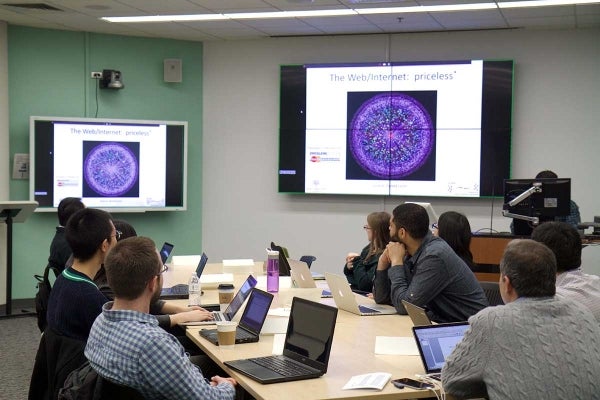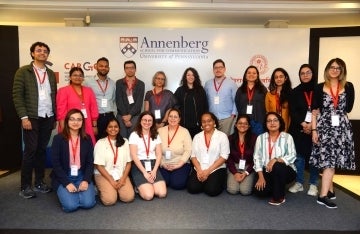Computational Social Science Course Brings Annenberg, Northwestern, and Wisconsin Together
The graduate course on the emerging field of computational social science brings the three schools together in real time.

Over his 40 years of teaching, Professor Joseph Cappella has always been keen to embrace classroom technology. A few decades ago, for example, he had a really fancy overhead projector. “It weighed about as much as a small Volkswagen,” he laughs. “Things have changed quite a bit.”
This spring, Cappella has been part of something innovative by 2016 standards: a graduate course on the emerging field of computational social science, run jointly in real time with students and professors at Northwestern University and the University of Wisconsin. A video system connects the classrooms, allowing the sites to see and hear each other, as well as guest lecturers who could be anywhere in the world.
It isn’t simply technology for technology’s sake. The setup enables Cappella and his co-teachers — Dhavan Shah at Wisconsin and Noshir Contractor at Northwestern — to teach this particular subject at the highest possible level.
“I wanted to have the opportunity to teach something in computational social science,” says Cappella, “but like a lot of brand new areas, particularly one as technical as this, no single person has sufficient expertise to do a good job with teaching this kind of cutting edge work.”
The three professors have specialized expertise in the field: Shah in computational text analysis, Contractor in computational approaches to network analysis, Cappella in the application of Amazon-like recommendation engines to health messages.
To complement their knowledge, the class hosted a luminary array of guest speakers, including Duncan Watts of Microsoft Research, one of the founding fathers in the field; Uri Wilensky of Northwestern, an expert in agent-based modeling; Lada Adamic of Facebook and the University of Michigan, who specializes in network connectivity across websites; Ron Burt of the University of Chicago who studies how social networks create competitive advantages in careers, organizations, and markets; Lyle Ungar, a Penn professor in Computer and Information Science as well as Psychology whose research develops scalable machine learning and text mining methods; and Annenberg professors Sandra González-Bailón and Damon Centola who focus on different aspects of network dynamics.
“I was absolutely blown away by the positive response that we had from speakers,” says Cappella.
In advance of each class, the students read two to four articles relevant to that week’s speaker, and drafted questions.
For the first third of the class, each week’s guest speaker would offer a lecture, often webcamming in from other locations. In the second segment of the class, students at each site asked questions of the speaker. Finally for the last part of the class, the classes went offline, and the professor at each site led a Q&A or discussion. A course website and Google Group also allowed participants share their bios, questions, and ideas.

In June, the class will meet in person at Northwestern, a meeting timed to coincide with the 2nd Annual International Conference on Computational Social Science being held there. Students will have a chance to meet all of their classmates, interact with many of the guest speakers from the course, and then attend the conference afterwards if they choose.
Nine Annenberg students are officially enrolled, but each week, nearly as many other students, postdocs, and visiting scholars sit in, just to learn — a quiet testimonial to how unique and exciting the class is.
Even the students themselves are diverse, with Northwestern bringing in a number of engineering and computer science students.
“We’re all used to doing transdisciplinary research, and it's time we start thinking about doing transdisciplinary teaching,” says Cappella. “Bringing in expertise from different domains is the only way this sort of computational social science course can work successfully.”
Each student pursued a research project, some continuing an ongoing project, while others began anew. For example, Doctoral Candidate Sijia Yang worked on testing four algorithms for making recommendations about anti-smoking PSAs to smokers, in hopes of being able to target each person with an ad that might be most effective for them. Doctoral Student Joshua Becker, meanwhile, studied a particular aspect of how ideas spread through networks: how people’s decisions are swayed by both well-known opinion leaders, but also by consensus, even if the popular solution to a problem isn’t the best one.

Cappella and his co-teachers may offer the course again in the future, but it wouldn’t be the same course, with the field developing and innovating so quickly that even a year later, the cutting edge will have advanced significantly.
“It’s great fun because it's challenging intellectually,” he says. “I'm learning stuff that’s new to me and I'm seeing old subjects taking new forms. The mathematical modeling I did when I was working on my dissertation has morphed in various ways to simulation and agent based modeling. A lot of things have changed with the tools.”
UPDATE: The three branches of the class met together in June at Northwestern, with many continuing on to three-day 2nd Annual International Conference on Computational Social Science at the Kellogg School.




